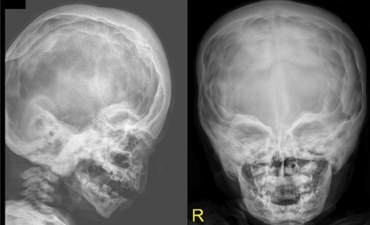Craniodiaphyseal dysplasia
| Craniodiaphyseal dysplasia | |
|---|---|
| Other names: CDD or Lionitis | |
 | |
| Craniodiaphyseal dysplasia has an autosomal recessive pattern of inheritance[1] | |
Craniodiaphyseal dysplasia (CDD), also known as lionitis, is an extremely rare autosomal recessive bone disorder that causes calcium to build up in the skull, disfiguring the facial features and reducing life expectancy.
These calcium deposits decrease the size of cranial foramina, and can decrease the circumference of the cervical spinal canal. In the few cases recorded, most of the sufferers died in childhood.
Signs and symptoms
The clinical presentation includes the following:[2]
- Abnormal rib morphology
- Coarse facial features
- Craniofacial hyperostosis
Cause
The underlying genetics are uncertain.[3]
Diagnosis

Among the medical signs are dacryocystitis, seizures, intellectual disability, and paralysis, each of which is a complication resulting from the diminutive foramina. A common sign reported as a result of the disease has been widely spaced eyes.[4]
Management
In terms of treatment, there is no cure for this condition, management depends on the symptoms displayed by the affected individual[5]
Society
Peter Bogdanovich's 1985 drama film Mask drew public attention to the case of Roy L. "Rocky" Dennis, an American boy who died of the disorder in 1978.[citation needed]
In the American medical drama Grey's Anatomy episode "Yesterday", Jesse Plemons plays a teenage boy suffering from lionitis. The main character of the two-issue comic book miniseries Friday the 13th: How I Spent My Summer Vacation by Wildstorm Productions is a 13-year-old boy suffering from the disorder. In the anthology television series [[American Horror Story]] season 1, Beauregard, the brother of Tate and Adelaide, suffered from lionitis.[citation needed]
See also
References
- ↑ "OMIM Entry - 218300 - CRANIODIAPHYSEAL DYSPLASIA; CDD". omim.org. Archived from the original on 19 January 2022. Retrieved 9 July 2017.
- ↑ "Craniodiaphyseal dysplasia - About the Disease - Genetic and Rare Diseases Information Center". rarediseases.info.nih.gov. Archived from the original on 27 July 2021. Retrieved 12 July 2022.
- ↑ Brueton LA, Winter RM (November 1990). "Craniodiaphyseal dysplasia". J. Med. Genet. 27 (11): 701–6. doi:10.1136/jmg.27.11.701. PMC 1017262. PMID 2277386.
- ↑ Reichenberger, Ernst; Chen, I.-Ping (1993), Adam, Margaret P.; Ardinger, Holly H.; Pagon, Roberta A.; Wallace, Stephanie E. (eds.), "Craniometaphyseal Dysplasia, Autosomal Dominant", GeneReviews®, Seattle (WA): University of Washington, Seattle, PMID 20301634, archived from the original on 2020-10-22, retrieved 2021-01-18
- ↑ Mankin, H. J. (23 September 2013). Rare Genetic Disorders That Affect the Skeleton. AuthorHouse. p. 75. ISBN 978-1-4918-1504-5. Archived from the original on 15 July 2022. Retrieved 13 July 2022.
External links
- Craniodiaphyseal dysplasia Archived 2021-04-21 at the Wayback Machine at orpha.net Archived 2008-03-15 at the Wayback Machine
| Classification | |
|---|---|
| External resources |
- Pages with script errors
- All articles with unsourced statements
- Articles with unsourced statements from May 2022
- Articles with invalid date parameter in template
- Articles with unsourced statements from September 2020
- Webarchive template wayback links
- Congenital disorders of musculoskeletal system
- Autosomal recessive disorders
- Genetic disorders with OMIM but no gene
- Rare diseases